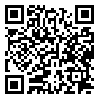Volume 21, Issue 4 (December 2023)
Iranian Rehabilitation Journal 2023, 21(4): 591-600 |
Back to browse issues page
Ethics code: IR.USWR.REC.1400.095
Download citation:
BibTeX | RIS | EndNote | Medlars | ProCite | Reference Manager | RefWorks
Send citation to:



BibTeX | RIS | EndNote | Medlars | ProCite | Reference Manager | RefWorks
Send citation to:
Azarnia S, Ezatti K, Naghdi S, Abdollahi I, Shanbehzadeh S, Baharloueii H et al . The Effect of Concurrent Transcranial Direct Current Stimulation and Robotic Training of the Upper Limb in Stroke Recovery: A Systematic Review and Meta-analysis. Iranian Rehabilitation Journal 2023; 21 (4) :591-600
URL: http://irj.uswr.ac.ir/article-1-1765-en.html
URL: http://irj.uswr.ac.ir/article-1-1765-en.html
Somaye Azarnia *1 

 , Kamran Ezatti2
, Kamran Ezatti2 

 , Soofia Naghdi3
, Soofia Naghdi3 

 , Iraj Abdollahi4
, Iraj Abdollahi4 

 , Sanaz Shanbehzadeh5
, Sanaz Shanbehzadeh5 

 , Hamzeh Baharloueii3
, Hamzeh Baharloueii3 

 , Shapoor Jaberzadeh6
, Shapoor Jaberzadeh6 




 , Kamran Ezatti2
, Kamran Ezatti2 

 , Soofia Naghdi3
, Soofia Naghdi3 

 , Iraj Abdollahi4
, Iraj Abdollahi4 

 , Sanaz Shanbehzadeh5
, Sanaz Shanbehzadeh5 

 , Hamzeh Baharloueii3
, Hamzeh Baharloueii3 

 , Shapoor Jaberzadeh6
, Shapoor Jaberzadeh6 


1- Student Research Committee, University of Social Welfare and Rehabilitation Sciences, Tehran, Iran.
2- Department of Physiotherapy, Faculty of Medicine, Guilan University of Medical Sciences, Rasht, Iran.
3- Musculoskeletal Research Center, Isfahan University of Medical Sciences, Isfahan, Iran.
4- Department of Physiotherapy, School of Rehabilitation, University of Social Welfare and Rehabilitation Sciences, Tehran, Iran.
5- Rehabilitation Research Center, Iran University of Medical Sciences, Tehran, Iran.
6- Department of Physiotherapy, Faculty of Medicine, Monash University, Melbourne, Australia.
2- Department of Physiotherapy, Faculty of Medicine, Guilan University of Medical Sciences, Rasht, Iran.
3- Musculoskeletal Research Center, Isfahan University of Medical Sciences, Isfahan, Iran.
4- Department of Physiotherapy, School of Rehabilitation, University of Social Welfare and Rehabilitation Sciences, Tehran, Iran.
5- Rehabilitation Research Center, Iran University of Medical Sciences, Tehran, Iran.
6- Department of Physiotherapy, Faculty of Medicine, Monash University, Melbourne, Australia.
Abstract: (3091 Views)
Objectives: Transcranial direct current stimulation and robotic therapy (RT) are two modalities in neurorehabilitation for the improvement of upper limb function in stroke patients. However, the additional effects of the concurrent application of these two techniques compared to RT alone on upper limb function in stroke patients have not been studied yet. We analyzed the effectiveness of concurrent tDCS and RT compared to RT alone on upper limb motor function in stroke patients.
Methods: A systematic search of PubMed, Scopus, Web of Science, CENTRAL, EMBASE, and Physiotherapy Evidence Database was performed from 2000 to January 1, 2021. The quality of the included studies was evaluated using the Cochrane risk-of-bias assessment tool. All statistical analyses were performed in STATA software, version 14, and the Mean±SD was used as the pooled statistics.
Results: The result showed that concurrent tDCS and RT had moderate but non-significant pooled effect sizes for upper limb Fugl-Meyer assessment (SMD=0.31, 95% CI, -0.20%, 0.83%, I2=84.1%).
Discussion: According to the results of this study, no difference was obtained in the efficacy of concurrent tDCS and RT compared to RT alone on upper limb function in stroke survivors.
Methods: A systematic search of PubMed, Scopus, Web of Science, CENTRAL, EMBASE, and Physiotherapy Evidence Database was performed from 2000 to January 1, 2021. The quality of the included studies was evaluated using the Cochrane risk-of-bias assessment tool. All statistical analyses were performed in STATA software, version 14, and the Mean±SD was used as the pooled statistics.
Results: The result showed that concurrent tDCS and RT had moderate but non-significant pooled effect sizes for upper limb Fugl-Meyer assessment (SMD=0.31, 95% CI, -0.20%, 0.83%, I2=84.1%).
Discussion: According to the results of this study, no difference was obtained in the efficacy of concurrent tDCS and RT compared to RT alone on upper limb function in stroke survivors.
Article type: Reviews |
Subject:
Physiotherapy
Received: 2022/09/4 | Accepted: 2022/12/25 | Published: 2023/12/1
Received: 2022/09/4 | Accepted: 2022/12/25 | Published: 2023/12/1
Send email to the article author





